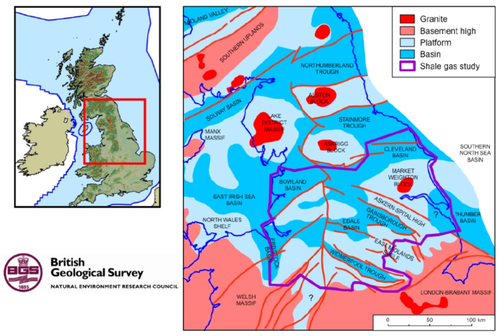Developments in British shale gas
 Prof. Michael H. Stephenson
Prof. Michael H. StephensonMike Stephenson, British Geological Survey
January 2013
On 13 December 2012 Edward Davey, Energy and Climate Change Secretary announced that exploratory hydraulic fracturing (fracking) for shale gas can resume in the UK, subject to new controls to mitigate the risks of seismic activity (details here). Fracking was suspended in May 2011 following two small seismic tremors near the country’s only fracking operations in Lancashire in the northwest of England. Following the May ban, intensive study of fracking in the area was commissioned by the UK Department of Energy and Climate Change (DECC) carried out by an independent panel of experts in seismology, induced seismicity and hydraulic fracturing (Dr Brian Baptie, BGS; Professor Peter Styles, Keele University and Dr Christopher A. Green, GFRAC ). The report can be downloaded here.
Amongst the recommendations were that: (1) hydraulic fracturing should invariably include a smaller pre-injection and monitoring stage before the main injection; (2) hydraulic fracture growth and direction should be monitored during operations; (3) future hydraulic fracturing operations in Lancashire should be subject to an effective monitoring system that can provide automatic locations and magnitudes of any seismic events in near real-time.
Perhaps most important, the report recommended that operations should be halted and remedial action instituted, if seismic events of magnitude 0.5 ML or above are detected. This has become known as a traffic light system.
A wide expert consultation also resulted in a report by the Royal Society and Royal Academy of Engineering (download report). Amongst the recommendations of this report were that national baseline surveys of methane and other contaminants in groundwater, as well as seismicity and residual stress, should be conducted. The report supported realtime monitoring as well as traffic light controls.
Following these consultations and reports the UK Government has concluded that the seismic risks associated with fracking can be managed effectively with controls which include:
- A prior review before fracking begins to assess seismic risk and the existence of faults;
- A fracking plan to be submitted to DECC showing how seismic risks will be addressed;
- Seismic monitoring carried out before, during and after fracking; and
- A new traffic light system to categorise seismic activity and direct appropriate responses. A trigger mechanism will stop fracking operations in certain conditions.
The other main development in Britain will be the release early in 2013 of the Bowland Shale Mapping and Resource Estimation. The work is being done by the British Geological Survey for DECC. This will be a very important milestone in British shale gas because it will provide a state-of-the-art figure for Gas in Place and reduce the uncertainty that has surrounded the question of the country’s potential in the last two years.
In 2010 DECC (BGS) estimated potential shale gas production from the Upper Bowland Shale in the north of England at 4.7 tcf using a basic comparison with the Barnett Shale of Texas. This was close to a reserve estimate though not carried out in the conventional way. In 2011 Cuadrilla produced an estimate of 200 tcf Gas in Place for a smaller area, with stacked shales. The two figures were widely misunderstood and misreported in the British press and considered by many to be a discrepancy. Despite attempts by scientists to explain the difference between reserve and resource estimates, the misconception has persisted, rather undermining public and investor confidence.
The new estimate will be an independent Gas in Place estimate for the north of England carried out by BGS geologists. The maps below indicate the area of interest.






